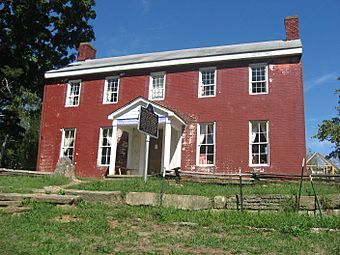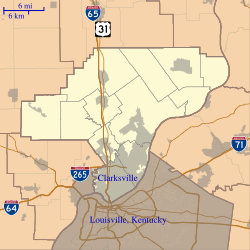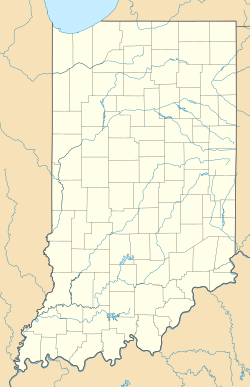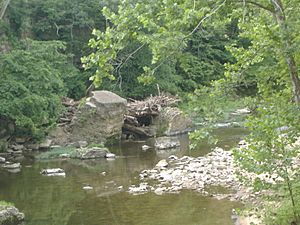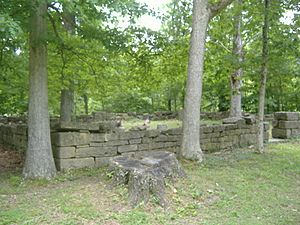John Work House and Mill Site facts for kids
The John Work House and Mill Site is a special place in Indiana. It's listed on the National Register of Historic Places. This means it's an important historical site. The land is just outside Charlestown. Today, the Lincoln Heritage Council, part of the (BSA), owns it. It's part of their Tunnel Mill Scout Reservation.
For about 100 years, this site had a busy gristmill. A gristmill grinds grain into flour. But over time, new technology made the mill less useful. Sadly, a fire later destroyed much of it. Two important natural features near the site are Fourteen Mile Creek and the Devil's Backbone. Now, the Boy Scouts use the land for fun camping activities. These include programs like National Youth Leadership Training and a Webelos Camp.
In 2010, a part of the Tunnel Mill camp was rented to a private company. This company is working to fix up the old John Work House. They want to turn it into a living history center. To keep the building safe from damage, security guards watch the property every night.
Contents
Building the Mill and House
The John Work House was built in 1811. John Work (born in 1760) used strong poplar wood from the forest to build it. The house was originally two stories tall and had six rooms. Each room had its own chimney.
In 1814, John Work decided to build a new gristmill. He had bought an older mill in 1804, but it needed many repairs. His new mill was built near the main road connecting Charlestown and New Washington to the growing city of Madison. John Work found a perfect spot where Fourteen Mile Creek curved around a limestone hill. The creek also dropped a lot in height there. This was great for powering a mill.
He decided to dig a tunnel through the hill. This tunnel would act as a "mill race." A mill race is a channel that directs water to power the mill wheel. This would give his mill a strong and steady water source. The tunnel was finished in 1816, and the mill itself was ready in 1818. Digging the tunnel was a big job! It needed a lot of gunpowder. The tunnel was about 6 feet (1.8 m) deep and 5 feet (1.5 m) wide. A dam was later built to help the mill work well all year. John Work also built three more mills further up the creek.
How the Mill Worked
The mill started working in 1819. It was in a great location. It was a day's ride from New Albany and Madison. These were two of Indiana's biggest cities back then. It was also very close to the Ohio River, which was important for shipping goods.
John Work added other businesses to his mill site. He had a sawmill to cut wood. There was also a saltworks (to make salt), a powdermill (to make gunpowder), and a still (to make alcohol). Tunnel Mill was also the first mill in the area to use a new system. It had elevators that moved corn around. This system was called Evans and Ellicott's machinery. It meant only two people were needed to run the mill, instead of six. This was a huge step forward in technology! The mill could handle about 2.5 barrels of corn every hour. Soon, Work's Mill was the best and busiest mill around. Even when many smaller local mills closed, Tunnel Mill kept going.
After John Work passed away in 1832, the mill had several different owners. Each owner made changes to keep up with the times. Work's mill was a "custom mill." This meant farmers brought their own corn to be ground for their families. Later owners changed it to a "merchant mill." Farmers would sell their corn to the mill. Then the mill would process it into flour, grits, or flakes to sell itself. Some of these products were shipped on the Ohio and Mississippi Rivers.
The mill's first wheel was made of oak wood. But in the mid-1800s, metal wheels became common. Wooden wheels only lasted 5-10 years before needing big repairs. When John Hunt Morgan led his raid in 1863, the mill was in danger. Morgan had taken money from other mills in Indiana. An addition was also built onto the house in the 1860s.
The mill kept working into the 1920s. It was the only gristmill left in Clark County. But it wasn't used much. Mills in Louisville were cleaner and more modern. People often used the mill area for swimming in the creek.
On August 1, 1927, a fire destroyed the mill building. No one knows for sure how it started. It might have been a dropped cigarette, a swimmer, or even the last owner, Henry Murphy. There were plans to rebuild the mill in 1958 and 1981, but they never happened. A garage was added to the house in the 1990s.
Work/Faris Cemetery
There is a cemetery on the property. It holds the graves of John Work, his wife Sarah Jackson, and other early settlers of Clark County. You can find it near the bridge across Fourteen Mile Creek. The last known burial there was in 1869.
Tunnel Mill Scout Reservation
In 1927, Henry Murphy decided to sell the 142 acres (0.57 km2) of land around the burnt mill. The new Boy Scout Council, called the George Rogers Clark Council, was looking for a camp area. This council included Scouts from Clark, Floyd, Harrison, Scott, and Washington counties. Local Troop 3 had used the Work property as a summer camp for three summers starting in 1917.
On April 2, 1928, Murphy sold the land to the Scouts. Many groups in the area helped improve the property. This allowed the camp to open in 1929. Three-sided cabins, like those used by pioneers, were built near the cemetery in 1933. In 1942, the Scoutmaster's Cabin and Evergreen cabins were finished. The McDonald Bridge was built across Fourteen Mile Creek in 1950.
The camp was most popular in the 1950s and 1960s. In 1960, 564 Scouts attended, which was the highest number ever. In 1969, a swimming pool was built. The creek was no longer safe for swimming. In the 1980s, the Work House was fixed up by the Camp Ranger, Jeff Streets. He then moved into the house. Since 1993, the property has been used less. This is because the George Rogers Clark Council joined with another council. Also, the rough land helps protect it from being built on. Since the merger, the camp is mostly used by Cub Scouts and for winter camping.
Local Legends
Many interesting stories and legends are told about the property. One story says that if you step on a certain step on the McDonald Bridge at night, a ghost will chase you! You have to run up the hill before it catches you. Another legend says there's hidden gold somewhere near the old mill. Some people even say the ghost of John Work haunts the mill's remains.
Sadly, these stories have made the property a target for vandals and ghosthunters. The people currently fixing up the house see ghost hunters as a big problem. They believe most ghost stories are just "campfire stories" made up by Boy Scouts or from popular TV shows about ghosts.
There's also a story about a silver mine. Local Native Americans would bring silver ore to Work to pay him for grinding their corn. When Work asked where the silver came from, they said they had a mine. But they would never tell any white person where it was. If such a mine exists, it hasn't been found yet. Some small Gold flakes have been found in the creek, enough to fill a tiny bottle.
The Site Today
Today, the property has a cabin village, a swimming pool, and a dining hall. The dining hall was built in 2000. It replaced an older one from the 1980s. Besides Scouts, the Civil Air Patrol also uses the property for training. The John Work House and the remains of the mill became part of the National Register of Historic Places in 2001.
Fixing up the old house was going to cost a lot of money. The Lincoln Heritage Council couldn't afford it. In 2010, the site was put on the "10 Most Endangered List" by Indiana Landmarks. This was because of all the damage from vandalism. But earlier that year, a private company called Taylor Rose Historical Outfitters made a deal with the Lincoln Heritage Council. This company specializes in supplies for historical reenactments. They agreed to fix and protect the John Work House. They rent the house for just $1 a year. Because of this, the Work House had "improved prospects" and was not on the endangered list in 2011.
The plan is for the house to become a place where people can learn about history. It will also be a workshop and store for the company's historical business. Future plans include classes, living history events, and a research library. They also hope to build a new mill, similar to the one John Work had.
Gallery
-
Order of the Arrow lodge


